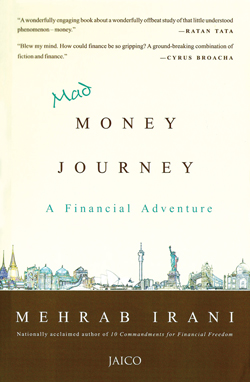It’s all about the money, honey
Published by: Jaico Books
ISBN-13: 978-81-8495-577-4
Pages: 229
Price: INR 229
The rich get richer, “I have to make it to the Forbes list,” they cry. The middle class get deeper in debt—“Sales online… just a mobile app away,” they sigh. And the poor seem to be getting poorer—“Daal mein aur thoda paani dalo,” to make the meal go around.
Whichever group we may belong to, our quest for money is soul-searing. Along comes Mehrab Irani who promises you financial nirvana, but only if you follow his ‘10 commandments of financial freedom’, which he introduced using a fictional account of two friends.
Dr John Pinto, an orthopaedic surgeon in posh South Mumbai, seems to have it all—a great job, an extravagant lifestyle and a loving family. And yet, at the age of 45, he tries to take his life—an attempt that is foiled by his childhood friend, Vijay Desai. The contrast between the two men is a dig at the Indian educational system. John, who had a brilliant academic career, failed himself spectacularly in life. But Vijay, a school dropout, rose to be not just an international business tycoon, but one with a heart.
When Vijay learned that John’s suicide attempt was brought on by his dwindling finances, he decided to take his friend—and the reader—on a financial pilgrimage. As you travel along with them, you visit not only the Meccas of money [New York and London] but also the massage parlours of Bangkok, the remote mountains of Afghanistan, the Australian outback, Kenyan safari, Kruger National Park and Shanghai water town amongst other places. The teachers of the 10 commandments are as exotic as their locales. There’s an ex-porn star, an ex-terrorist, a marathon runner and, predictably, an ex-Wall Street investment banker. The one factor they share in common is that they are all protégés who have been ‘rescued’ by Vijay and taught financial emancipation, which they will now pass on to John.
The author’s skills as a teacher shine through in this book. Each chapter deals with a single financial precept—equities, real estate, insurance, budgeting, allocation of resources and even speculation. The lesson is embedded in parable and brings out the connection between man and money. The financial lesson is summarised at the end of each chapter feels like the moral of an Aesop’s fable. Sometimes, these lessons seem repetitive but I guess that is necessary for reinforcement. At times though, the lesson is difficult.
As the main aim of the book is to make you financially savvy, you will need to overlook some small flaws. The character of Dr John Pinto is sketchy and rather unconvincing. Most of the author’s aphorisms seem to be largely drawn from ‘inspirational internet forwards’ but what works is the way he neatly weaves them into the story. While the underlying lesson is clear, the attention to detail is lacking and this tends to take away a bit from the story.
The New York chapter is the most compelling with an entertaining and brilliant lesson on investing in equities. I am sure this is what prompted Rakesh Jhunjhunwala to call his book “a page turner that will permanently change the way you look at life and money.” And I heartily agree!
This was first published in the November 2014 issue of Complete Wellbeing.

